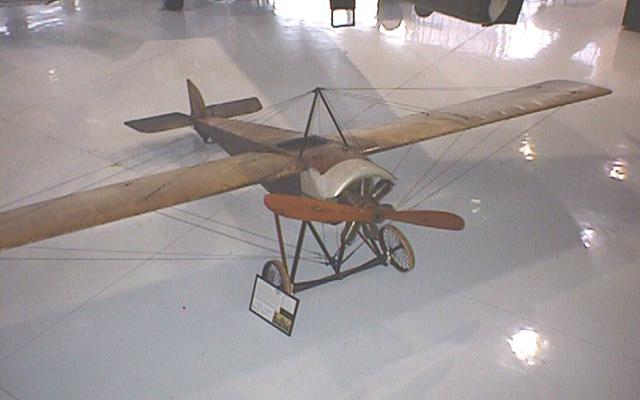
1916 Brock Morane
Walter Brock was an American who learned to fly in England in 1912. He quickly moved on to becoming a flight instructor and became the first pilot to deliberately take off in winds of gale strength.
Brock achieved fame as a racing pilot, scoring victories all over Europe until the beginning of World War I. The most famous and prestigious race he won was on July 11, 1914, from London to Paris. The aircraft he flew was a Morane-Saulnier H-type Monoplane, powered by an 80 hp Gnome Rotary engine. However his European racing days came to an abrupt end when war broke out and all British civilian aircraft were ordered to be turned over to the military.
In 1916, using “parts” he brought back with him from Europe, Brock built this aircraft using a smaller 50 hp Gnome engine. How much of the racer he brought back is a matter of speculation. This aircraft has almost the same lines as the 1914 racing aircraft but is about 3 feet shorter. Was the fuselage cut down to ship home because of a size issue? Who knows? By renaming it the Brock Monoplane, he may very well have been covering for his friends back in England who had helped him get the aircraft out of the country.
Why was the engine not shipped? Would it have been too obvious? Or did he feel that he could save on shipping and get one easily in the States (which he did)? How much of the original aircraft is in this airplane is anybody’s guess. We may one day learn more when the aircraft is restored back to flying condition.
Specifications
- Year Built — 1916
- Wingspan — 30’10”
- Top Speed — 75 mph
- Gross Weight — 750 lbs
- Engine — Gnome rotary (50 hp)
Kermit’s Comments
This aircraft has no ailerons for roll control in banking. It uses the wing-warping technique, like a bird that actually “twists” one wing up while the other wing “twists” down.
As with all rotary engines, the propeller is bolted to the engine, and they spin as one unit. Fuel is fed in through the fixed crankshaft where it enters the crankcase and is atomized by the hot moving parts. On any piston engine, inlet valves open to allow the fuel mixture to enter the cylinders. After the inlet valve closes, the fuel is ignited by the sparking plugs where the resulting explosion creates the engine’s power. Unique to the 50 hp Gnome is the fact that its inlet valves are located in the tops of the pistons, not in the cylinders as in most engines. Because of this, carbon accumulates on valves quickly and the engine must be torn down and the valves cleaned every 10 hours of running time.